| |
|

Cover Story:
HOW THE SAN FRANCISCO SPCA LET US DOWN
By Susan Dyer Reynolds
Photos by Jane Richey
With only 14 percent of its dogs coming from
San Francisco, the once-revered shelter is a shell
of its former self – and animals are dying
n a spring afternoon, Rocket Dog Rescue founder Pali Boucher makes one of her almost-daily trips through the “stray and surrender” kennels at San Francisco’s city-run shelter, Animal Care and Control. The dank rooms full of cement and chain-link smell of feces, and the endless barking of anxious, frightened dogs is deafening. These are society’s throwaways – surrendered by their owners or picked up as strays; the dogs the public doesn’t see. Boucher makes it her mission to give these animals a chance – she marks their cards with “CIP,” short for “call interested party,” so they won’t be euthanized while she searches for foster homes, and she gives the mostly nameless dogs names, scribbling them on the card that describes how each dog wound up here: “Owner didn’t want anymore,” “Picked up as stray,” “Family couldn’t afford.” There is a surprisingly wide array of breeds, from all-American mutts to purebred Dachshunds, Dobermans and Jack Russell terriers. On this particular day, Boucher notices that one of the dogs she had marked CIP is not in his cage; she stops a kennel attendant to ask her to help find the dog, but the attendant says it will have to wait – she needs to euthanize a dog first.
“Which dog?” Boucher asks. “The little grey pit bull,” the attendant answers. Boucher knows the dog; in fact, she jotted her “A” number down – a number starting with the letter “A” that the shelter uses to track each animal – the day before, but by the time she got to the front counter to have it added to the list of CIP holds for Rocket Dog, the shelter was closed. She explains this to the attendant, but is told it is too late – once the euthanasia is scheduled, there is no turning back. Annie, a volunteer who has come along with Boucher, hangs her head. Undaunted, Boucher asks if she can spend some time with the dog before she is put down. The attendant agrees.
Boucher and Annie arrive at the kennel to see the dog exactly as she had been the day before – shut down, shivering, her head shoved in the corner as if trying to disappear. According to her card, she was found in a basement where she likely spent her entire life. They slip into the cage and sit down beside the dog, a pretty, petite gray Staffordshire terrier around a year old, whom Boucher has named Maggie Mae.
Despite Boucher’s soft cooing, Maggie stays pressed in the corner; finally, Boucher pulls the dog into her lap. Maggie remains rigid, her head covered with scratches from burying it in the cement. Boucher rocks gently and talks to her, while Annie begins to cry. When the attendant appears at the cage, Boucher holds Maggie tight. “You can’t put this dog down,” Boucher tells her. “I have her ‘A’ number written in my book; I was going to put a CIP on her yesterday, but the shelter had already closed ...” The attendant, like everyone who works at ACC, knows how passionate Boucher is, and, despite a job that could make anyone hard and jaded, they root for her and the throwaway dogs. “OK,” the attendant says. “But get her into the system today.” Boucher nods. Maggie is still stiff, her haunted eyes dark and vacant. “You’re life is going to get better from here,” Boucher tells the dog, who slinks out of her lap and back into the corner. “I promise.”
On another spring afternoon, my friend Johnny and I walk up to the Safeway on Market Street to buy a few groceries. A woman is standing in front with a laid-back blue nose pit bull, and I stop to say hello and tell her how beautiful her dog is. “There is one named Shiloh that looks just like him at the SF/SPCA,” she informs me. “And he’s going to be put down if someone doesn’t get him out of there.”
I look at Johnny and he rolls his eyes, knowing me too well. We head over to the SF/SPCA to ask about Shiloh.
In stark contrast to ACC, which runs on a budget of about $3 million per year, the San Francisco Society for the Prevention of Cruelty to Animals has one of the highest rates of public donations of any private shelter in the country, receiving over $23 million in contributions for the fiscal year ending June 30, 2007, and according to the 990 (a financial report for the Internal Revenue Service that nonprofits must make available to the public upon request) for 2008, net assets were nearly $70 million. Unlike the dismal prison-like conditions just across the street at ACC, the SF/SPCA is a veritable glamour slammer, where dogs and cats are housed in sunny, glass-walled “condos” with furniture and TVs.
When I ask a volunteer about Shiloh, she says he doesn’t sound familiar and is most likely at ACC. Johnny and I walk across the street and ask an ACC volunteer, who informs us that Shiloh is indeed being fostered at the SF/SPCA – for Rocket Dog Rescue. It struck me as odd that the SF/SPCA would be fostering a dog for an independent rescue group, but I take the number and call founder Pali Boucher, who agrees to meet me there.
In the lobby, Boucher explains that Shiloh’s owner brought him to the SF/SPCA and insisted they take the 9-year-old pit bull because she had to move. The SF/SPCA doesn’t take surrendered animals – that’s ACC’s job – but the woman refused to take no for an answer because she perceived the SF/SPCA to be “no kill” and wanted to be sure Shiloh found a home. Boucher got a call asking her to take the dog, but all of her foster homes were full, so the SF/SPCA agreed to “foster” Shiloh for two weeks. Boucher was relieved that Shiloh had a two-week reprieve, but she asked if I wanted to go across to ACC to look at some dogs that weren’t so lucky. I followed her through the stray and surrender kennels, where I met dog after dog facing death because ACC was overflowing and the SF/SPCA had declined them. She slips into the cage of a cute Chihuahua mix with a pink sign that reads “Unable to approach,” indicating that the dog is vicious. Boucher sits down on the floor and within seconds the dog is in her lap, tail wagging, licking her face.
We move down the row where I meet Maggie, the little grey Staffie nearly euthanized. Boucher tells me that while ACC doesn’t have the money or the staff to work with dogs like Maggie, they are wonderful about letting her come spend time with them. In just a few short weeks, she says, the difference in Maggie is amazing. Maggie is still shivering in the corner, but when she sees Boucher she comes to the front of her cage. Maggie is still shut down and timid, but it is obvious that Boucher, likely the only person who has ever shown her kindness, has begun to gain her trust.
In another row we meet Cooper, a huge, stunningly handsome red-nose pit mix. Boucher is worried about him. “Two foster homes have fallen through,” she tells me. “I have to get him out of here.”
Most of the dogs we meet are desperate for attention and eager for affection, pressing against the chain-link for even a small scratch on the head … and I wonder why the SF/SPCA hasn’t taken them.
In 1994, under the direction of then-president Richard Avanzino, the SF/SPCA signed an Adoption Pact with ACC in which Avanzino agreed to take all healthy animals that came into the city-run shelter, as well as many with medical and behavior issues. Prior to the Pact, ACC was euthanizing nearly 6,000 animals a year due to budget and space constraints. Because of the pact, by the time Avanzino retired five years later, the number had decreased to just over 2,900, and of those, over 1,900 were untreatable, mostly due to serious illness. At the time, nearly half the dogs coming into ACC were pit bulls and pit bull mixes, and Avanzino asked ACC’s then-director, Carl Friedman, to exempt them from the pact. Because so many pit bulls were being euthanized, Friedman took the matter into his own hands, and in 2006 created a mandatory spay/neuter ordinance for all pit bulls in San Francisco. The measure was controversial, but the numbers were undeniable: Between 2004 and 2006, 32 percent of the dogs impounded were pit bulls; by 2008, that number had dropped to 22 percent. Nationally, only one in 900 pit bulls or pit mixes makes it out of the shelter alive. Currently, the SF/SPCA will only take two pits or pit mixes at a time. Boucher says it is because they don’t move as quickly as the small dogs the SF/SPCA prefers. “They don’t do any positive PR for pit bulls either,” she says. “I find good homes for a lot of pit bulls, so someone out there wants them.”
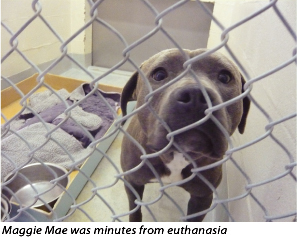 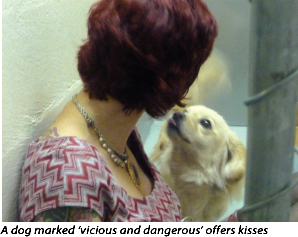 "I followed her through the stray and surrender kennels, where I met dog after
"I followed her through the stray and surrender kennels, where I met dog after
dog facing death because ACC was overflowing and the
SF/SPCA had declined them."
I was so moved by my visit with the throwaway dogs that I decided to do a series of chapters about it for my Northside San Francisco column, “Jasmine Blue’s Tails of the Dog Park.” I began following Boucher regularly on her trips to the shelter, and, like the story of Shiloh, more and more things just didn’t add up. Boucher informs me that her group is having a harder time than ever before trying to place more and more dogs left behind at ACC. I ask if it is due to the economy, and she shrugs. “Maybe there are some extra dogs, especially purebreds, showing up, but the main reason is that the SF/SPCA takes so few.”
At a January 8, 2009 meeting of the Commission of Animal Control and Welfare (ACW) – which advises the Board of Supervisors regarding animal issues in the City – animal care supervisor Eric Zuercher presented some startling statistics: While the SF/SPCA took 122 dogs from ACC in 2007-08, independent rescues took far more. Grateful Dogs Rescue, which gets 80 percent of its dogs from ACC, took 141 in 2007, and 146 in just the first three quarters of 2008. Rocket Dog Rescue, which, Zuercher stated deals with the toughest cases (pit bulls, medical issues), took 111. Other groups also stepped in – Muttville takes older dogs, Wonderdog takes a lot of small dogs. The 122 taken by the SF/SPCA represents just 14 percent of the total dogs they took in 2008.
Where cats are concerned, the SF/SPCA fairs better, with 73 percent of its cats coming from ACC in 2008, though that is down from 84 percent in 2007. The percentage of cats taken from other shelters jumped from 16 percent in 2007 to 25 percent in 2008.
Toni’s Kitty Rescue saved 200 kittens in just four months, all of which would have been euthanized otherwise because ACC does not adopt out kittens under eight weeks of age (and the SF/SPCA won’t take them). Lana Bajsel’s Give Me Shelter gets 95 percent of its cats and kittens from ACC – they currently have 100 cats in their system on an $80,000-a-year budget, while the SF/SPCA has just 170. Without the rescues, Zuercher concludes, many more animals would have died.
“We would be so greatly diminished without the rescues,” Zuercher says. “They astound me and inspire me with the amount of effort they put into this.”
He also admires Boucher and her ability to take the throwaway dogs – abandoned by their owners, often abused and neglected, failed by ACC, and declined by the SF/SPCA. “She’s an amazing person. She takes the dogs that wouldn’t have a chance otherwise, finds them homes, and gives them a new life.”
Grateful Dogs administrative director Kim Durney says she knows why the SF/SPCA takes so few dogs from ACC. “They want a pet store filled with only the cutest dogs,” she says.
After a 26-year career at Bank of America, Durney left the corporate world and devoted herself to grassroots rescue: “I was volunteering at the SF/SPCA and one day I crawled in the kennel with two dogs. I saw from their eye level how many people walked by and looked for two seconds and kept walking. The dogs would look so hopeful. It was a pivotal moment for me.”
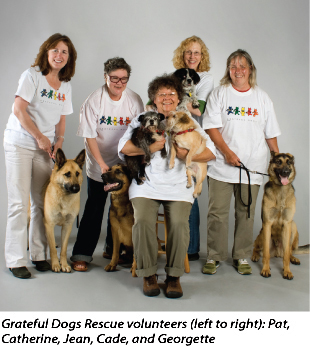 Boucher says she doubts most people realize that the
Boucher says she doubts most people realize that the
SF/SPCA declines dogs for such minor issues. “To me,
failing due to medical means they’ve been run over by a
car, or have terminal cancer – I think most people assume
they are putting the dog out of its misery.”
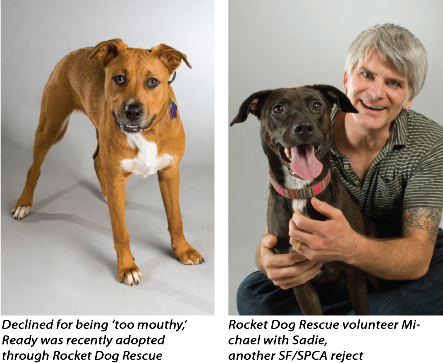
Like many other rescue groups, she is highly critical of the SF/SPCA. “If you want to take 90 percent of your dogs from outside the county, that’s fine,” Durney says. “But be honest about it. People don’t want to hear that the group they’ve been giving money to all these years isn’t saving San Francisco’s dogs. They’ve been riding on their reputation for years, but it’s not true anymore.”
Rescues were also angered to discover that SF/SPCA veterinarian Jennifer Scarlett, while volunteering with Rural Area Vet Services, brought 45 animals back from an American Indian reservation in Arizona. Some arrived sick and one was a pit bull puppy – dogs that would have been rejected from ACC.
At the January ACW meeting, SF/SPCA vice president Dori Villalon defended taking animals from other shelters, saying that in 2007-08, they took 1,500 animals from other shelters in the Bay Area and Central Valley that otherwise would have been euthanized. These animals, Villalon explained, did not require medical care or behavior rehabilitation as the animals declined from ACC did. She also asserted that taking those animals gives the other shelters “breathing room” by relieving overcrowding. 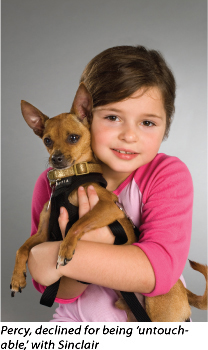
Unfortunately, the facts, particularly in regard to the Central Valley, prove Villalon dead wrong: Fresno County alone kills between 60,000 and 70,000 homeless animals annually, making its euthanasia rate the highest per capita in the nation. Kathleen Hendron, a volunteer with the small, rural Selma shelter, which falls under the auspices of the Central California SPCA in Fresno, says that 99 percent of the dogs that come in are not fixed. When asked if the animals taken by the SF/SPCA relieves overcrowding, she gasps. “Absolutely not! It doesn’t make a dent. The only thing that is going to help us is spay and neuter education, money for spay and neuter clinics, and mandatory spay and neuter laws.”
Hendron points to Operation California Canine Cuties, where 54 small dogs were flown from Fresno to Edmonton, Canada, by dog lover and philanthropist Janet Folk on her private jet. “Evidently they have a shortage of cute, small dogs in Edmonton,” Hendron says. “We are seeing an explosion of Chihuahua mixes, and while it was great to see those 54 dogs get out of here, the very next day, the shelter was full again.”
Durney of Grateful Dogs agrees with Hendron. “The SF/SPCA is not making a difference in these overcrowded shelters by taking a few animals. The only way for them to really make a difference is to use some of their resources to help these places fund education and spay/neuter programs, and to put their big name and big dollars behind supporting mandatory spay and neuter laws.”
Durney thinks the SF/SPCA’s real reason for taking the majority of its dogs from other counties is that they want to “cherry pick” to ensure they have the youngest, cutest, healthiest dogs; the ones that move the quickest and make their “live release rate” look good. As a private shelter, I tell her, the SF/SPCA has the right to do that, and Durney doesn’t disagree. “They want the most adoptable dogs, but for me it’s not about whether the dog is adoptable, it’s whether the dog is savable. They decline dogs for really fixable things – minor medical conditions or behavior issues like food guarding.” She also points out that “live release” simply means that the animal left the shelter alive. “When an animal doesn’t work out, the SF/SPCA will send it back to the high-kill shelter where it came from rather than euthanize it here. That way it counts as a live release.”
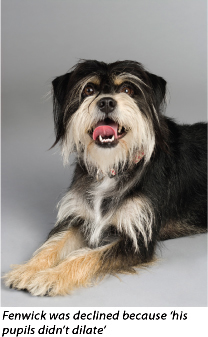 Boucher agrees that the SF/SPCA cherry picks. “I’ve seen the transports come in from the Central Valley – little dogs, purebred dogs; super-desirable dogs like golden retrievers. They like the cute and fluffies, not the old and uglies.” Boucher agrees that the SF/SPCA cherry picks. “I’ve seen the transports come in from the Central Valley – little dogs, purebred dogs; super-desirable dogs like golden retrievers. They like the cute and fluffies, not the old and uglies.”
She also agrees that they decline animals at ACC based on very simple issues. “The paperwork I get for the dogs declined by the SF/SPCA usually says the reason is medical or behavioral. They rejected a young Pekinese with dry eye, which is really common in the breed – all she needed was eye drops. I’ve gotten dogs with notes that say ‘cataracts, cloudy eyes, flea allergy, food guarding, and stiffness.’ Well, cloudy eye and cataracts are common in older dogs; flea allergies can be taken care of with Advantage; food guarding – they have a team of behaviorists, and food guarding is usually pretty easy to cure … and stiffness? The dogs have been lying on cold, cement floors – you’d be stiff, too.”
Boucher says she doubts most people realize that the SF/SPCA declines dogs for such minor issues. “To me, failing due to medical means they’ve been run over by a car, or have terminal cancer – I think most people assume they are putting the dog out of its misery.”
While the SF/SPCA insists it adheres to the Adoption Pact, Boucher says the dogs she and other rescues take from ACC prove otherwise since they go on to thrive in loving adoptive homes. “Yes, some of them need medical attention or a little behavior work, but that’s the whole point of rescue, right?” Boucher asks rhetorically. “You save the animal, you work with the animal, you find the animal a home.”
But taking those toughest cases also comes at a price: Rocket Dog incurred over $150,000 in medical bills last year alone. Surprisingly, Boucher rarely takes the dogs she rescues from ACC to the SF/SPCA’s state-of-the-art new hospital. “I can’t afford it,” she says. Like many rescues in San Francisco, Rocket Dog goes to private veterinarians or other shelters that offer lower rates and better discounts. “The SF/SPCA offered me a 30 percent discount on spays,” she says. “But 30 percent off of $450 is still really expensive. I go to the East Bay SPCA, where they will do spays for $50.”
Durney says Grateful Dogs doesn’t deal with the SF/SPCA hospital either. “They’re difficult to work with, they’re too expensive, and they want you to sign a form agreeing not to disparage them.”
Boucher was asked to sign the same agreement, but she also refused. “Why would they want us to sign something saying we won’t say anything disparaging if they didn’t think there was anything disparaging to say?”
The 60,000-square-foot hospital, which opened earlier this year, has become a source of controversy for the SF/SPCA with more than just the rescue groups – donors have also expressed deep concerns. The Leanne B. Roberts Animal Care Center, the second largest veterinary hospital in North America (number one in the size of its medical area) began with a $17-million donation from the Roberts Family Trust, but the cost ballooned to $30 million. The board of directors took out a $7 million line of credit, began seeking additional donations specifically for the hospital, and even pulled money from the general fund to cover part of the project, angering donors who thought their money was going directly to the animals. In 2006 alone, over $1.2 million was spent on design, engineering and construction. The first year deficit is expected to run over half a million dollars, requiring more loans, more interest, and more dipping into the general fund.
“Why did they build a hospital San Francisco didn’t need?” Durney asks. “It was supposed to be a specialty hospital, but they backed off of that. Now, with their high prices, they are just competing with other private vets.”
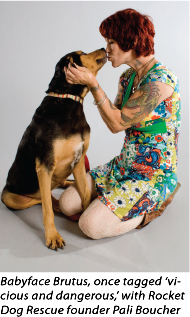 One ex-volunteer who asked to remain anonymous said that she didn’t begrudge the SF/SPCA a new hospital – the old one was substandard and in disrepair – but she does question the bloated cost and enormous size when she personally has heard management using budgetary problems as a reason not to take animals: “I think in part it’s because the board is very out of touch; they’re a bunch of rich people who really have no idea what goes on in the trenches everyday. How can you cry poor when it comes to taking dogs and cats but have no problem spending $30 million on a giant hospital?” One ex-volunteer who asked to remain anonymous said that she didn’t begrudge the SF/SPCA a new hospital – the old one was substandard and in disrepair – but she does question the bloated cost and enormous size when she personally has heard management using budgetary problems as a reason not to take animals: “I think in part it’s because the board is very out of touch; they’re a bunch of rich people who really have no idea what goes on in the trenches everyday. How can you cry poor when it comes to taking dogs and cats but have no problem spending $30 million on a giant hospital?”
I decided to pose that question, along with others I’d heard from the rescue and volunteer communities, to Jan McHugh-Smith, president of the SF/SPCA since February 2007. Kiska Icard, a member of the public relations team, called to schedule the interview. With McHugh-Smith’s busy schedule, she said, the soonest available date was three weeks away. I took it, and continued my research.
As word spread about the story, my phone began to ring off the hook with past and present volunteers and employees eager to talk about what they had seen and heard. All asked to remain anonymous, fearing retribution from what I was beginning to find out was a very unpopular and mistrusted regime.
I reached out to Icard for statistics on a range of topics, from how many animals they had taken from ACC so far this year to what McHugh-Smith’s salary was to how many people they had working in their marketing department and how much they were making. She continuously referred me to the 990s on Web sites like Charity Navigator and GuideStar – despite the fact neither the 2007 nor 2008 forms had been posted yet.
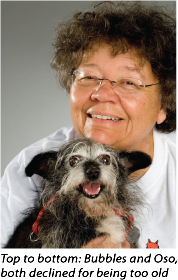
Since taking over as editor of the Marina Times in 2002, I’ve had a good relationship with the SF/SPCA, donating ad space to showcase their adoptable animals, helping to promote their events, and running articles written by staff. When I bought the newspaper, along with Northside S.F., in 2006, I expanded that relationship. Our Marina Times “Pet Page” editor, Cindy Beckman, is a former SF/SPCA behavior department volunteer, and remains a staunch supporter. As recently as last month, McHugh-Smith penned an article for the Marina Times about the SF/SPCA’s cat program. So I was disappointed when Icard called me the day before my interview, for which I had waited nearly a month, and informed me that McHugh-Smith wanted to cancel. “She doesn’t feel it’s in the best interest of the organization for her to participate in your article,” Icard said. While I was disappointed, I was not surprised: The SF/SPCA has long been a media darling and has grown accustomed to having P.R.-friendly softballs lobbed at them.
A few weeks later, Icard was laid off with seven other employees – mostly marketing staff, along with the chief financial officer. When I 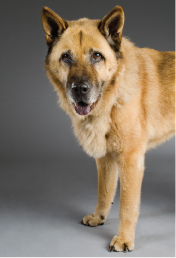 finally obtained the 2008 990, it revealed that Icard was one of the five highest paid employees, with a salary of nearly $115,000 per year. The 990 also showed that McHugh-Smith made nearly $237,000 and received a 5 percent fixed-rate loan for $500,000 from the SF/SPCA to purchase a home in Marin. Vice president Villalon, whom McHugh-Smith had worked with in Colorado and brought onboard, made $145,000. While it is not uncommon for executives of nonprofits to make six figures, the fact the SF/SPCA has been slashing important programs and pointing to budget problems as a reason for declining animals has critics crying foul. finally obtained the 2008 990, it revealed that Icard was one of the five highest paid employees, with a salary of nearly $115,000 per year. The 990 also showed that McHugh-Smith made nearly $237,000 and received a 5 percent fixed-rate loan for $500,000 from the SF/SPCA to purchase a home in Marin. Vice president Villalon, whom McHugh-Smith had worked with in Colorado and brought onboard, made $145,000. While it is not uncommon for executives of nonprofits to make six figures, the fact the SF/SPCA has been slashing important programs and pointing to budget problems as a reason for declining animals has critics crying foul.
I sent a list of questions to Villalon via e-mail, but received a reply from the director of communications, Tina Ahn, explaining that Villalon was not interested in participating in the article either because she felt it would be “journalistically biased.” Indeed, the questions posed were tough, but I am always skeptical of an organization where the top brass is unwilling to sit down and defend their position.
Ahn also forwarded answers from McHugh-Smith, most of which I’ve heard in other media interviews. As to why they take so few dogs from ACC, she responded that it was because ACC’s adoption program was so successful. In regard to the SF/SPCA’s policy on killing animals, she said that no “friendly, healthy” animal is ever euthanized at the SF/SPCA. I thought “friendly” was an odd choice of words – what about the shy animals, like Maggie? Shyness can come across as unfriendly; so can nervousness – most animals are nervous in a shelter environment. And any animal with a behavior issue, no matter how minor, will certainly not come across as friendly.
“Healthy” also leaves out a huge number of shelter animals, and it goes against Avanzino’s vision for the Adoption Pact: to take all dogs and cats (except, unfortunately, pit bulls) – even medical and behavior cases.
The pact categorizes cats and dogs three ways: “adoptable,” “treatable” and “nonrehabilitatable.” The only animals the SF/SPCA should be rejecting from ACC are the “nonrehabilitatable,” and the definition of those animals is very narrow: cats and dogs for whom euthanasia is the most humane alternative due to disease or injury; vicious cats and dogs, the placement of whom would constitute a danger to the public; cats and dogs who pose a public health hazard; and cats and dogs the adoption of whom would violate policy.
Nowhere in this verbiage does it say they will take only “friendly, healthy” animals.
Former SF/SPCA public relations coordinator and longtime volunteer Karin Jaffie has been an outspoken critic of the SF/SPCA’s new direction. “When I was laid off, it was because they [wanted to] get rid of malcontents. They kept offering me more – first an $8,000 severance, then $10,000 – to sign a confidentiality agreement. I said ‘no way’ because I wasn’t going to keep quiet.”
Jaffie points out that McHugh-Smith has scaled back or slashed respected behavior and medical services and, in perhaps the most controversial move, she eliminated the 30-year-old Hearing Dog Program, which turned shelter dogs into service dogs. McHugh-Smith told the three employees that their jobs and the program had been eliminated because it cost $400,000 more than it made in donations. Hearing dog trainer Martha Hoffman and program director Glenn Martyn were instructed to leave immediately, and, in a final, humiliating blow, were escorted off the premises by Villalon. Ironically, this occurred the day after the SF/SPCA’s 140th anniversary celebration where the hearing dog demonstration was a huge hit with the crowd of supporters and donors. The 13 dogs who paraded around showing off their skills were put back into the general adoption population, even though there were people waiting for them. McHugh-Smith said the dogs were not ready to graduate, but Jaffie disagrees. “They taught one of the dogs to turn the lights on for the big celebration cake at the event. They looked pretty ready to me.”
Angry staffers and volunteers have quit in protest. “A lot of people are unhappy with the changes,” Jaffie says. “And the hospital, no matter how great, is an issue. They got rid of the free spay and neuter program for pit bulls and now the Hearing Dog Program – for the cost of that hospital they could spay and neuter every pit bull in the City for free and train a lot of service dogs.”
This past spring, the SF/SPCA went to court in San Mateo County to claim $500,000 that was bequeathed to the now-defunct Hearing Dog Program. The judge awarded it to them, along with an additional $500,000 from the same family.
Lana Bajsel, director of Give Me Shelter, San Francisco’s largest cat rescue, is another of the SF/SPCA’s most outspoken critics. Bajsel is horrified by the stories she hears from ACC officers who have been responding to more abuse and neglect cases for animals adopted from the SF/SPCA since McHugh-Smith loosened adoption regulations. “They adopted out a dog named Maverick to a guy in the Tenderloin,” she says. “The neighbors complained he was being abused. ACC confiscated the dog and the SF/SPCA said they would take him back. Everyone assumed they would put him up for adoption again, but they euthanized him instead.” The ACC officer, Bajsel says, was outraged.
In a 2008 SF Weekly article (“A Time to Kill,” by John Geluardi, June 11 issue), McHugh-Smith defended the loosening of adoption standards, saying, “People can get animals from thousands of places: the Internet, in front of Safeway, from family and friends … Why would we make it more difficult for them?”
Bajsel is also angered by stories of people being turned away at the new hospital for financial reasons. “An elderly woman showed up with her dead dog at ACC,” Bajsel says. “She had taken the animal to the SF/SPCA for care, but it died there. She didn’t have the money for disposition, so the SF/SPCA told her to bring it to ACC.”
In another case, the hospital refused to treat a dog in respiratory distress because his owner had a balance of $109 from 1999. “The dog died,” Bajsel says. One owner took his dog to ACC after being refused by the SF/SPCA, also for financial reasons. “It turned out to be a simple abscess,” Bajsel explains. “Dr. Bing at ACC treated the dog at no charge.”
Like many other rescue groups, she doesn’t use the SF/SPCA spay/neuter clinic. “I can get cats
done in Oakland or San Jose for $20, and in Palo Alto for $12. The SF/SPCA charges $140 for females and $100 for males.”
She thinks it’s wrong that cash-strapped ACC has to partner with the Peninsula Humane Society for the “Go Nuts!” program, which offers free spaying and neutering. “The SF/SPCA has a hospital the size of two football fields and tons of money, but they can’t offer free spay and neuter to rescues and low-income pet owners?”
Bajsel is also an outspoken critic of vice president Villalon. “They have this retail mentality,” she says. “At one ACW meeting Dori compared animals to jeans – she said, like with jeans, you can’t give people too many choices.”
Villalon is no stranger to controversy. Her difficult relationship with volunteers and rescues at her previous post as director of Sonoma County’s Humane Society – which she left just short of her one-year probation to join her former colleague McHugh-Smith at the SF/SPCA – are well documented
Paws for Love, an organization started at the Sonoma shelter that raised $250,000 a year for medical needs, was ousted from its small space in the facility because Villalon said she needed it for storage.
A van, purchased for $160,000 by the Sonoma shelter’s volunteer board for much-needed mobile spay and neuter clinics, sat mostly unused.
Critics also accused Villalon of boosting live release rates at the Sonoma shelter by dispersing animals under the name of a local nonprofit – many were sent without being spayed or neutered and later could not be accounted for. In one particularly egregious case, they accused Villalon of adopting out a puppy with a broken leg. When they tried to trace the puppy, they discovered the adopters had given a fake address. The puppy was never located.
Longtime animal welfare advocate R.J. Kamprath says that Villalon also refused to improve services for the Hispanic community. “We had a meeting about increasing bilingual services and Dori said, ‘I’m not going to help those people.’ I was completely shocked!” In a presentation to the Sonoma Board of Supervisors, Kamprath alerted them to Villalon’s comments, as well as to the fact she still had not implemented Spanish on the shelter’s phones or spay/neuter hotline.
Answering her Sonoma critics in an August 2008 interview with Tom Vacar of KTVU, Villalon said, “I was brought in to make change, and implementing some of those changes was hard for people.”
Yet, this past June, nearly two years after Villalon resigned, a Grand Jury report chastised the shelter for not using the mobile van, for not tapping into the county’s wealth of animal welfare activists, and for not making bilingual information available.
New animal care director Amy Cooper says all of these things are a priority for her, and she is thrilled to be onboard to help Sonoma’s shelter turn things around. “We are trying not to look back, but we don’t want to repeat history. Understanding our demographic is very important – it’s bigger than just a language issue. We want to do outreach. And we definitely want to reduce our euthanasia rates.”
Give Me Shelter’s Bajsel, who is working on legislation to make San Francisco a “no kill” city, says the cat is definitely out of the bag on that front: “For years the SF/SPCA held the gun to the animal’s head and made ACC pull the trigger. They were the wonderful no-kill place, and ACC was the villain. But now they actually pull the trigger themselves.”
Julene Johnson, a UCSF professor who works with FixSanFrancisco.org, a group seeking to end the killing of San Francisco’s sheltered animals, was so concerned about comments she heard at an SF/SPCA volunteer meeting held by McHugh-Smith and staff that she sent a letter to former board member Jim Ludwig:
“During a meeting with the volunteers, we discussed Jan’s perspective on No Kill. The staff explained that ‘no kill’ was an unrealistic goal and that ‘low kill’ was a better term. However, when one volunteer asked, ‘What do we tell the public when they ask if the SPCA is a no kill shelter?’ the staff person responded, ‘Say we are a no kill shelter.’ I was shocked, to say the least.”
Another huge issue for critics like Bajsel and Johnson is the controversial behavior testing methods used by both ACC and the SF/SPCA. Many of the methods are considered antiquated and ineffective, particularly in a shelter environment – running at the cage of a dog to see if it startles or cowers, pulling food away from hungry animals with a fake hand, yanking on the tail of a cat.
ACC’s acting director Rebecca Katz agrees that the testing could be improved. “A shelter is not a good environment to be 100 percent certain,” she says. “There are many animals that don’t pass and do great in homes – the rescues prove that. And we are starting a foster program – I think getting animals out of this environment is key.”
Katz also wishes the SF/SPCA would take more of the medical and behavior cases. “I would like to see their team of behaviorists work with some of these animals,” she says. “They used to take more behavior dogs, but they said they were spending 20 percent of their funding on 2 percent of the dogs.”
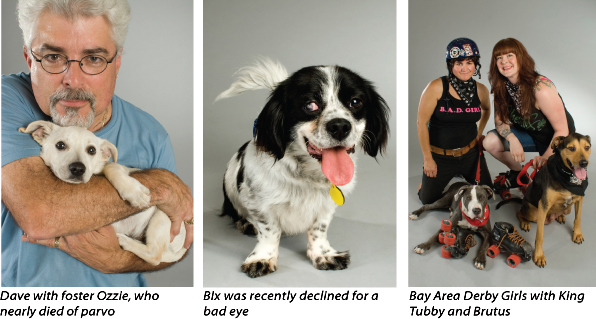
Compounding the problem, Katz says, is the fact that the SF/SPCA recently cut an annual $60,000 grant to ACC for their behavior and training program. “When Carl Friedman was the director here, the SF/SPCA asked to be allowed to take three passes a month on any animals they chose. In return, Carl asked for $60,000 so ACC could have its own behavior and training program. They just cut that grant.”
Like many others, Katz doesn’t think taking a few animals out of overwhelmed shelters is a good use of the SF/SPCA’s time or resources. “My ideal model is to go to the Central Valley and get them to take responsibility and do more to reduce their overpopulation problem; to support them with education and spay and neuter programs. Our SPCA has the power and funding to do this. Just taking dogs from a bottomless bowl doesn’t solve the problem.”
Deb Campbell, ACC’s volunteer and outreach coordinator, says one good thing has come from the discord at the SF/SPCA. “A lot of the volunteers who have left are now with us. We have more than 30 ex-SPCA cat behaviorist volunteers who have started two amazing programs for owner-surrendered cat and feral kitten socialization. They get them right at intake, and in a week we can handle these cats and kittens – they’ve been a godsend for us.”
On an afternoon visit to the SF/SPCA, I am surprised at how few animals are available for adoption in the beautiful but kennel-challenged facility. The majority of dogs are small, young and cute, with the two requisite pit bulls, an old lab mix or two, and one puppy that immediately grabs my heart.
Her name is Belle, a sweet 7-month-old Australian Kelpie mix from a shelter in Yuba City. Belle had a rough beginning – she was born with a congenital defect in one front leg, and as a youngster she contracted distemper, which manifested in constant neurological twitching. Several employees and volunteers come by to tell me how much they love her, and it is evident how much they care. When a woman comes to take Belle for a walk, she is tender and gentle as she leads her down the hall. “The right home will come along for her,” the volunteer says. “A really special home that she deserves.”
“The volunteers, even the unhappy ones, stay for the animals.
They’re afraid of what will happen if they leave. None of us want to see
the animals hurt by this. We just want things to get better; we want the
SF/SPCA to be all that it can be, and right now it isn’t.”
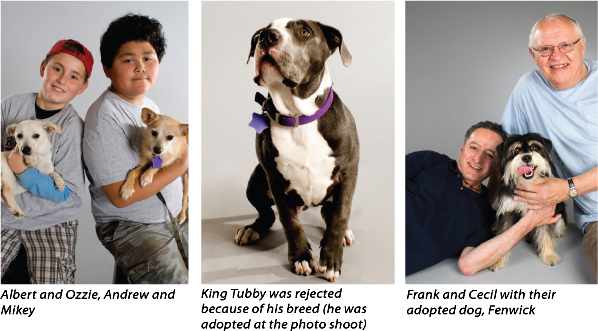
Durney is skeptical. “They always have one poster dog to use for getting donations,” she says. “How many other dogs with medical issues did you see?” I point out that the volunteers seemed to genuinely care about Belle. “I know they do,” Durney says. “The volunteers, even the unhappy ones, stay for the animals. They’re afraid of what will happen if they leave. None of us want to see the animals hurt by this. We just want things to get better; we want the SF/SPCA to be all that it can be, and right now it isn’t.”
Boucher agrees. “We all just want the SF/SPCA to work harder for the animals,” she says, but as I continue tagging along on her shelter visits, it is clear that won’t happen any time soon. When a puppy Rocket Dog has taken from ACC comes down with the deadly parvovirus and infects several other puppies, their treasurer, Paul, makes payment arrangements with the SF/SPCA hospital so they can bring the dogs in for treatment. They agree on $500 a month for the $8,000 bill, which is all that Rocket Dog can afford. On August 5, Villalon sends an e-mail to Boucher: “We were expecting payment of $1,000 on August 1 and have not received it. Please check in with your treasurer and submit the check by the end of this week. As agreed, please also drop off post-dated checks each in the amount of $1,000 so we can deposit them every month until the account is paid in full.”
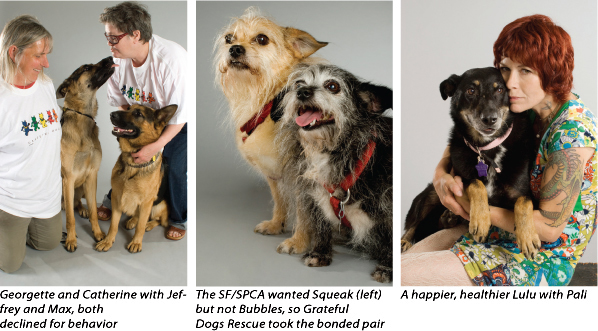
Both Boucher and Paul respond that they made arrangements for $500 a month, and that is all they can afford. In another e-mail dated August 6, Villalon responds: “As a nonprofit we understand the challenges you have regarding expenses and making decisions based on resources. We make these difficult decisions every day when we visit ACC and decline animals because we don’t have the means to care for them.”
Boucher, who lives on about $15,000 per year, was stunned by Villalon’s statement. “I would never decline a dog because we didn’t have the means to care for them. We can always find a way.”
She is frustrated with Villalon’s handling of Rocket Dog’s medical expenses, too. “We’ve had a 10-year relationship with the SF/SPCA,” she explains. “We have never not paid a bill. We have also stepped in to save dogs when they have asked – difficult cases – at great cost to our group.”
I point out that Pets Unlimited, another private nonprofit in the City, requires full payment at the time of service. “That’s why we brought them to the SF/SPCA,” Boucher says, “because they needed care immediately and they offered us a payment plan of $500 a month. But the biggest difference is that we are not taking dogs for Pets Unlimited – we are not having to step in and save dogs that they should be saving.”
Boucher’s phone rings; it is a staff member at the SF/SPCA. They want her to get Shiloh, the 9-year-old pit bull out by Saturday. “They are going to put him down otherwise,” Boucher says. “I don’t have a foster home for him. I don’t know what I am going to do.”
Though she is already at capacity, Boucher takes Shiloh into her own home until she can find him a foster.
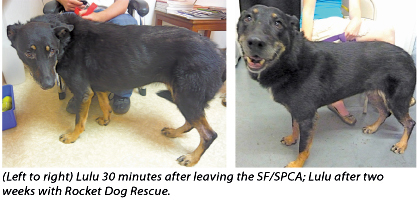 The next day an e-mail flies around to all of the rescue groups. It is from a volunteer in Lake County who says a senior shepherd mix named Lulu they sent to the SF/SPCA failed for food guarding and they want the dog sent back to Lake County. Boucher fears that if Lake County can’t take the dog back, the SF/SPCA will euthanize her. I agree to make an appointment for the dog with my veterinarian, Dr. Sherman Wong at Blue Cross Pet Hospital. When the dog arrives with Rob, a Rocket Dog volunteer, I am shocked at her condition: her entire back is void of fur due to a flea allergy, and her ribs are poking out. “No wonder she failed for food guarding,” Rob says. “She’s starving.” The next day an e-mail flies around to all of the rescue groups. It is from a volunteer in Lake County who says a senior shepherd mix named Lulu they sent to the SF/SPCA failed for food guarding and they want the dog sent back to Lake County. Boucher fears that if Lake County can’t take the dog back, the SF/SPCA will euthanize her. I agree to make an appointment for the dog with my veterinarian, Dr. Sherman Wong at Blue Cross Pet Hospital. When the dog arrives with Rob, a Rocket Dog volunteer, I am shocked at her condition: her entire back is void of fur due to a flea allergy, and her ribs are poking out. “No wonder she failed for food guarding,” Rob says. “She’s starving.”
Dr. Wong agrees that the dog is emaciated. “Hey, sweet old girl,” he says, cradling her head in his hands. “All you need is a nice bath and three square meals.”
In an e-mail, Boucher asks the SF/SPCA if they treated the dog medically. They respond that she was tested for heartworm and that’s it. Boucher sends a photo of the dog to the Lake County volunteer who assures her that the dog did not look like that when she left.
Both Boucher and Paul respond that they made arrangements
for $500 a month, and that is all they can afford. In another
e-mail dated August 6, Villalon responds: “As a nonprofit we
understand the challenges you have regarding expenses and
making decisions based on resources. We make these difficult
decisions every day when we visit ACC and decline animals
because we don’t have the means to care for them.”
While Boucher works on placing the shepherd mix, she receives a call from ACC asking her to take a puppy that came in with parvovirus. She explains that the puppy needs aggressive treatment right away. ACC agrees to take the dog to the SF/SPCA hospital for treatment, and Boucher promises to take the puppy once he recovers. Because Boucher does so much for them, ACC agrees to pay for the treatment. Again, I am struck by the lack of involvement on the part of the SF/SPCA; that ACC, on a severely limited budget, must pay for treatment, and that Boucher, already overwhelmed with dogs, must take the puppy – an adorable little Dachshund mix – and try to find it a home. To add insult to injury, while Boucher is making arrangements for the puppy, Villalon teeters up to her in the lobby of ACC. Dressed in four-inch heels and a form-fitting designer suit, Villalon begins pressing Boucher for a payment again.
Later, while we wait in the high-ceilinged lower level lobby of the new hospital for word on another dog, a family walks up to the desk and tells the clerk, a woman named Maria, that they don’t want their puppy anymore. “You want to surrender it?” Maria asks, without looking up. The man says he does. Maria points behind her. “Take it across the street to ACC,” she says. “The SPCA doesn’t take animals.”
The family – a man, his wife, and young son – leave the hospital lobby looking confused. Boucher follows them outside and quickly realizes that it is the father who doesn’t want the dog. He tells Boucher that he paid a lot of money for the 5-month-old purebred miniature schnauzer named Bruno but, with their son going back to school, they don’t have time for him. The family follows Boucher back into the hospital lobby, where she gently counsels them on their options. I am sitting eye level with the young boy, whose eyes well up with tears. His mother also starts to cry. “Here,” the man says suddenly, and drops the puppy in Boucher’s lap. He turns to his wife. “Don’t you cry,” he warns her. “Bruno has Pali now. Let’s go.” As the family leaves the whining puppy behind, the man says to his wife, “Now that the dog is gone, you can go home and clean the house.”
I am shocked, but Boucher is not – she sees it everyday. “It’s OK,” she says, stroking Bruno softly. “I have a friend who has a big schnauzer network – she’ll find you a home in no time.”
A couple of weeks later on August 26, I get a distraught e-mail from Boucher asking if I can help her find a place to board some dogs while she searches for foster homes. ACC has sent her a list of 14 animals that will be euthanized the next day if she cannot get them out. The dogs are nameless and faceless, listed only by their kennel numbers. Boucher tells me that I have met three of the dogs – two 8-year-old purebred Rotweiller sisters and a purebred Doberman pinscher. I recall them well. The Rot sisters were dumped at ACC by their owners who didn’t want to pay for veterinary care as the dogs headed into their senior years. The Dobie was found as a stray in Golden Gate Park, likely also a case of owner abandonment. All three dogs are “friendly and healthy,” and I see absolutely no reason why the SF/SPCA has declined them, but they have, along with the 11 other dogs condemned to death.
On one of my visits with Boucher, we took the two Rotties to the exercise yard at ACC where they cavorted on the fake lawn and lifted their heads to take in the first breaths of fresh air they’d had since their owners left them behind. Despite being ripped from everything they’ve ever known, the pair is amazingly balanced and good-natured, just happy to stretch their legs and sniff the bushes.
In an ironic twist, Boucher turns in desperation to the East Bay SPCA (see Page 16, "The East Bay SPCA is a shining new model for Bay Area shelters"). It runs on a budget just slightly higher than ACC’s and usually pulls animals only from the East Bay – and they offer to take some of the dogs, including the Rotweiller sisters, until Boucher can find foster homes for them.
A few days later, Boucher receives a voice message from a woman looking to place two 120-pound Rotweillers with a rescue group. The dogs, owned by an elderly man with severe dementia, come with a donation for their care from the man’s estate. When Boucher calls the woman back an hour later, she informs her that the SF/SPCA has already agreed to take the two Rotweillers, sight unseen.
The day the 14 dogs are declined from ACC, I also receive an e-mail from an ex-volunteer informing me that a shipment of dogs had arrived at the SF/SPCA from the Central Valley. I am certain they are all young, small and cute – no “old and uglies,” no dog over 40 pounds, no “difficult-to-adopt-breeds” like Rotweillers or Dobermans that might not move out of their hallowed condos quite as quickly, thus making their “live release rate” look a little less impressive. The SF/SPCA’s P.R. machine will churn out another message saying they take all “friendly, healthy” animals; but most of the ACC dogs I met with Boucher over my four months researching this article fit that category. The SF/SPCA will, of course, say there was a reason to decline them; and their supporters will continue to justify their actions by pointing out that they are a private shelter. But the question remains: should the San Francisco SPCA be allowed to violate the Adoption Pact on technicalities?
Though severely underfunded and understaffed, ACC must take some blame in this as well. It is their inadequate testing methods that set many dogs and cats up for failure, giving the SF/SPCA the excuse it needs to reject otherwise adoptable animals. The paperwork I viewed for numerous rejected dogs indicated that the SF/SPCA “declined based on ACC’s notes.” Despite the fact the SF/SPCA has a team of behaviorists, it is easier to let ACC do the testing and take their word for it. ACC is also lax in pushing for enforcement of the Adoption Pact, preferring instead to depend on overwhelmed, underfunded rescue groups to save the animals, while the SF/SPCA sits back and takes all the credit. In reality, if the rescue groups did not take the majority of unwanted animals in San Francisco, the SF/SPCA’s live release rates would plummet – and that would be bad for business.
The biggest blame of course, lies with careless, irresponsible owners who don’t spay and neuter their pets, abuse and neglect them, and abandon them when they grow old, sick or inconvenient. The SF/SPCA’s lack of community outreach, refusal to make free spay and neuter easily accessible to the people who need it most, and unwillingness to work with and offer more assistance to the rescue groups is also key. Not to mention that somewhere in those 60,000 square feet at the Leanne B. Roberts Animal Care Center, there must be a little spare room for a few more dogs and cats – they could fit 50 kennels in the light and airy upstairs lobby alone.
Through all the politics, infighting and responsibility shirking, one thing is undeniable: the animals in the City of Saint Francis are dying – and no one besides a few grassroots rescue groups seems to care.
On a sunny summer afternoon, I walk up to a house in San Bruno where general contractor Tom Dickinson is waiting. Before he has the chance to greet me, a little grey Staffordshire terrier beats him to it. The dog wiggles up to me with that famous pit bull smile, wagging her tail. As I crouch down to give her a scratch behind the ears, she reaches up and kisses me. It’s Maggie Mae.
Shortly after I met Maggie at ACC, I agreed to foster her, provided she got along with my dog, Jasmine Blue. I brought Jazzy to ACC to meet Maggie, but while we were waiting, the third foster home for Cooper fell through because the woman thought he was too big. This was his last chance. “I don’t have room for him,” Boucher told me. About that time we noticed Jazzy and Cooper kissing through the fence of the exercise area. That day, a journalist on a story became a foster parent (see Page 18, “Why did Cooper fall through the cracks?”). Knowing how poorly Maggie was doing in the doggie insane asylum surroundings of the stray and surrender kennels, Boucher took her home that night.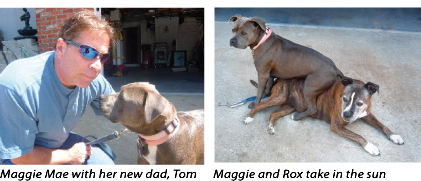
Just a few months from the day Maggie had been doomed to death because she was shy and unsocialized, I now see the epitome of a friendly, healthy dog.
Dickinson tells me that his older pit bull, Rox, had been diagnosed with lymphoma and given just a couple of months to live. He came to Rocket Dog Rescue distraught, saying that he wanted to adopt another dog while Rox was still alive. Boucher knew that Maggie was the perfect match.
Over the next several weeks, Dickinson visited Maggie regularly, and he brought Rox to meet her as well. The chemistry was instant.
Together, Dickinson and Boucher worked with Maggie, teaching her simple tasks like how to go up and down stairs and how to walk on a leash. But when he brought Maggie home, she was still fearful. “I would come home at night and she would bark at me,” Dickinson says as Maggie crawls into his lap. “But she finally started coming out of her shell.” Maggie squirms away and wanders over to Rox who is lying in the sun. Maggie promptly sits down on Rox, and Rox lifts her head. The two sweetly kiss. “They sit like that a lot,” Dickinson says, smiling. And there’s been a wonderful side effect to bringing Maggie into the family: Rox’s vet says she is actually doing better.
Maggie wanders back to Dickinson and crawls into his lap once more. “We can even go to dog parks now,” he says proudly. “She’s not completely comfortable in the world yet, but she’s going to be a great dog.” He nuzzles Maggie’s face and she takes a deep sigh. “I know it’s going to take some time, but that’s OK. She’s worth it.”
Now more than ever, foster homes and forever homes are needed for dogs and cats of all breeds and sizes. To inquire about fostering, volunteering, adopting or donating, please contact the following rescues. You can also find out about upcoming adoption fairs by calling or visiting these Web sites:
Rocket Dog Rescue
P.O. Box 460826
San Francisco, CA 94146
415-756-8188
www.rocketdogrescue.org
Grateful Dogs Rescue
P.O. Box 411013
San Francisco, CA 94141
415-587-1121
www.gratefuldogsrescue.org
Give Me Shelter Cat Rescue
P.O. Box 411013
San Francisco, CA 94141
415-810-7284
www.givemesheltersf.org
Muttville
P.O. Box 410207
San Francisco, CA 94141
415-350-6700
www.muttville.org
Wonder Dog Rescue
3288 21st St. #213
San Francisco, CA 94110
415-756-1306
www.wonderdogrescue.org
If you are looking for a pet, please consider adoption through a rescue or a shelter like San Francisco Animal Care and Control, 1200 15th Street at Alabama, 415-554-6364. To view adoptable pets online, visit www.sfgov.org/site/acc, or www.PetFinder.com.
The Commission of Animal Control and Welfare meets on the second Thursday of each month (except December) at 5:30 p.m. in Room 408, City Hall. Meetings are open to the public and public comment is permitted. Agendas are viewable 72 hours in advance. For more information, visit http://sfgov.org/site/awcc_meeting.asp?id=1344 or e-mail HelpAnimals@FSFACC.org.
E-mail: susan@northsidesf.com


|
|
|
|











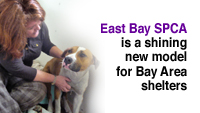

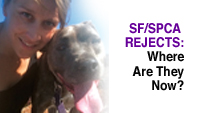


 Boucher agrees that the SF/SPCA cherry picks. “I’ve seen the transports come in from the Central Valley – little dogs, purebred dogs; super-desirable dogs like golden retrievers. They like the cute and fluffies, not the old and uglies.”
Boucher agrees that the SF/SPCA cherry picks. “I’ve seen the transports come in from the Central Valley – little dogs, purebred dogs; super-desirable dogs like golden retrievers. They like the cute and fluffies, not the old and uglies.” One ex-volunteer who asked to remain anonymous said that she didn’t begrudge the SF/SPCA a new hospital – the old one was substandard and in disrepair – but she does question the bloated cost and enormous size when she personally has heard management using budgetary problems as a reason not to take animals: “I think in part it’s because the board is very out of touch; they’re a bunch of rich people who really have no idea what goes on in the trenches everyday. How can you cry poor when it comes to taking dogs and cats but have no problem spending $30 million on a giant hospital?”
One ex-volunteer who asked to remain anonymous said that she didn’t begrudge the SF/SPCA a new hospital – the old one was substandard and in disrepair – but she does question the bloated cost and enormous size when she personally has heard management using budgetary problems as a reason not to take animals: “I think in part it’s because the board is very out of touch; they’re a bunch of rich people who really have no idea what goes on in the trenches everyday. How can you cry poor when it comes to taking dogs and cats but have no problem spending $30 million on a giant hospital?”
 finally obtained the 2008 990, it revealed that Icard was one of the five highest paid employees, with a salary of nearly $115,000 per year. The 990 also showed that McHugh-Smith made nearly $237,000 and received a 5 percent fixed-rate loan for $500,000 from the SF/SPCA to purchase a home in Marin. Vice president Villalon, whom McHugh-Smith had worked with in Colorado and brought onboard, made $145,000. While it is not uncommon for executives of nonprofits to make six figures, the fact the SF/SPCA has been slashing important programs and pointing to budget problems as a reason for declining animals has critics crying foul.
finally obtained the 2008 990, it revealed that Icard was one of the five highest paid employees, with a salary of nearly $115,000 per year. The 990 also showed that McHugh-Smith made nearly $237,000 and received a 5 percent fixed-rate loan for $500,000 from the SF/SPCA to purchase a home in Marin. Vice president Villalon, whom McHugh-Smith had worked with in Colorado and brought onboard, made $145,000. While it is not uncommon for executives of nonprofits to make six figures, the fact the SF/SPCA has been slashing important programs and pointing to budget problems as a reason for declining animals has critics crying foul.

 The next day an e-mail flies around to all of the rescue groups. It is from a volunteer in Lake County who says a senior shepherd mix named Lulu they sent to the SF/SPCA failed for food guarding and they want the dog sent back to Lake County. Boucher fears that if Lake County can’t take the dog back, the SF/SPCA will euthanize her. I agree to make an appointment for the dog with my veterinarian, Dr. Sherman Wong at Blue Cross Pet Hospital. When the dog arrives with Rob, a Rocket Dog volunteer, I am shocked at her condition: her entire back is void of fur due to a flea allergy, and her ribs are poking out. “No wonder she failed for food guarding,” Rob says. “She’s starving.”
The next day an e-mail flies around to all of the rescue groups. It is from a volunteer in Lake County who says a senior shepherd mix named Lulu they sent to the SF/SPCA failed for food guarding and they want the dog sent back to Lake County. Boucher fears that if Lake County can’t take the dog back, the SF/SPCA will euthanize her. I agree to make an appointment for the dog with my veterinarian, Dr. Sherman Wong at Blue Cross Pet Hospital. When the dog arrives with Rob, a Rocket Dog volunteer, I am shocked at her condition: her entire back is void of fur due to a flea allergy, and her ribs are poking out. “No wonder she failed for food guarding,” Rob says. “She’s starving.” 

